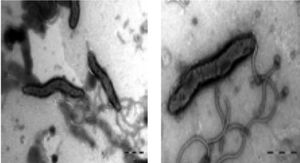Helicobacter cinaedi: Difference between revisions
No edit summary |
No edit summary |
||
| Line 20: | Line 20: | ||
==References== | ==References== | ||
[1] Fox, J. 2002. ‘’The non-''H pylori'' helicobacters: their expanding role in gastrointestinal and systemic diseases’’. ''Gut''. 50:273-83. [2] Andersen, L. 2001. ‘’New Helicobacter species in humans’’. ''Digestive Diseases''. 19:112-5. | [1] Fox, J. 2002. ‘’The non-''H pylori'' helicobacters: their expanding role in gastrointestinal and systemic diseases’’. ''Gut''. 50:273-83. | ||
[2] Andersen, L. 2001. ‘’New Helicobacter species in humans’’. ''Digestive Diseases''. 19:112-5. | |||
[3] Vandamme, P., Falsen, E., Rossau, R., Hoste, B., Segers, P., Tytgat, R., and De Ley, J. 1991. "Revision of ''Campylobacter, Helicobacter,'' and ''Wolinella'' taxonomy - emendation of generic descriptions and proposal of ''Arcobacter'' gen-nov". ''International Journal of Systematic Bacteriology''. 41:88–103. | [3] Vandamme, P., Falsen, E., Rossau, R., Hoste, B., Segers, P., Tytgat, R., and De Ley, J. 1991. "Revision of ''Campylobacter, Helicobacter,'' and ''Wolinella'' taxonomy - emendation of generic descriptions and proposal of ''Arcobacter'' gen-nov". ''International Journal of Systematic Bacteriology''. 41:88–103. | ||
[4] Perez-Perez, G. and Blaser, M. 1996. ‘’''Campylobacter'' and ''Helicobacter''. In: Baron, S. ''Medical Microbiology.'' 4th Ed. Galveston (TX): University of Texas Medical Brand at Galveston. Chapter 23. | [4] Perez-Perez, G. and Blaser, M. 1996. ‘’''Campylobacter'' and ''Helicobacter''. In: Baron, S. ''Medical Microbiology.'' 4th Ed. Galveston (TX): University of Texas Medical Brand at Galveston. Chapter 23. | ||
[5] Han, Y., Smibert, R. and Krieg, N. 1989. ‘’Occurrence of Sheated Flagella in ''Campylobacter cinaedi'' and ''Campylobacter fennelliae''". ''International Journal of Systematic and Evolutionary Microbiology''. 39:488-490. | [5] Han, Y., Smibert, R. and Krieg, N. 1989. ‘’Occurrence of Sheated Flagella in ''Campylobacter cinaedi'' and ''Campylobacter fennelliae''". ''International Journal of Systematic and Evolutionary Microbiology''. 39:488-490. | ||
[6] Schauer, D. 2001. ‘’Enterohepatic ''Helicobacter'' Species’’. ''Helicobacter pylori: Physiology and Genetics''. Washington (DC): ASM Press. Chapter 43. | [6] Schauer, D. 2001. ‘’Enterohepatic ''Helicobacter'' Species’’. ''Helicobacter pylori: Physiology and Genetics''. Washington (DC): ASM Press. Chapter 43. | ||
[7] Gebhart, C., Fennell, C., Murtaugh, M., and Stamm, W. 1989. ‘’''Campylobacter cinaedi'' Is Normal Intestinal Flora in Hamsters’’. ''Journal of Clinical Microbiology''. 27:1692-4. | [7] Gebhart, C., Fennell, C., Murtaugh, M., and Stamm, W. 1989. ‘’''Campylobacter cinaedi'' Is Normal Intestinal Flora in Hamsters’’. ''Journal of Clinical Microbiology''. 27:1692-4. | ||
[8] Hoist, H., Andersen, K., Blom, J., Hojlyng, N., Kemp, M., Krogfelt, K., and Christensen, J. 2008. ‘’A Case of ''Helicobacter cinaedi'' Bacteraemina in a Previously Healthy Person with Cellulitis’’. ''Open Microbiology Journal''. 2:29-31. | [8] Hoist, H., Andersen, K., Blom, J., Hojlyng, N., Kemp, M., Krogfelt, K., and Christensen, J. 2008. ‘’A Case of ''Helicobacter cinaedi'' Bacteraemina in a Previously Healthy Person with Cellulitis’’. ''Open Microbiology Journal''. 2:29-31. | ||
Latest revision as of 03:11, 21 July 2013
Classification
Bacteria; Proteobacteria; Epsilon Proteobacteria; Campylobacterales; Helicobacteraceae
Helicobacter cinaedi

Description and Significance
Helicobacter cinaedi was first isolated in 1984 in rectal swabs from male homosexuals, whom most were immunocompromised [1]. It has also been isolated from patients with enteritis and proctitis along with other species of its genus, such as H. fennelliae, H. pullorum,H. westmeadii, H. canadensis, and H. rappini [2]. Helicobacter cinaedi was initially identified as Campylobacter cinaedi, until 1991 due to molecular analysis [3]. It most commonly causes enteric and extraintestinal diseases [4].
Structure, Metabolism, and Life Cycle
Helicobacter cinaedi is a non-spore forming gram-negative bacterium. Like H. pylori, H. mustelae, and H. fennelliae, it has a G-C value between 35 to 40 mol%. It exhibits a darting motility by use of a single sheathed flagellum. Its fatty acid composition includes tetradecanoic acid, hexadecanoic acid and octadecenois acid [5]. Unlike Helicobacter pylori, Helicobacter cinaedi does not produce urease [6].
Ecology and Pathogenesis
Helicobacter cinaedi is found normally in the intestinal flora of hamsters [7]. It can cause bacteraemia, diarrhea and focal colonic lesions in humans. Cellulitis and arthritis is seen in a high percentage of patients infected with Helicobacter cinaedi. It is seen to be resistant to ciprofloxacin but treatment with tetracycline and various aminoglycosides is successful [1].
References
[1] Fox, J. 2002. ‘’The non-H pylori helicobacters: their expanding role in gastrointestinal and systemic diseases’’. Gut. 50:273-83.
[2] Andersen, L. 2001. ‘’New Helicobacter species in humans’’. Digestive Diseases. 19:112-5.
[3] Vandamme, P., Falsen, E., Rossau, R., Hoste, B., Segers, P., Tytgat, R., and De Ley, J. 1991. "Revision of Campylobacter, Helicobacter, and Wolinella taxonomy - emendation of generic descriptions and proposal of Arcobacter gen-nov". International Journal of Systematic Bacteriology. 41:88–103.
[4] Perez-Perez, G. and Blaser, M. 1996. ‘’Campylobacter and Helicobacter. In: Baron, S. Medical Microbiology. 4th Ed. Galveston (TX): University of Texas Medical Brand at Galveston. Chapter 23.
[5] Han, Y., Smibert, R. and Krieg, N. 1989. ‘’Occurrence of Sheated Flagella in Campylobacter cinaedi and Campylobacter fennelliae". International Journal of Systematic and Evolutionary Microbiology. 39:488-490.
[6] Schauer, D. 2001. ‘’Enterohepatic Helicobacter Species’’. Helicobacter pylori: Physiology and Genetics. Washington (DC): ASM Press. Chapter 43.
[7] Gebhart, C., Fennell, C., Murtaugh, M., and Stamm, W. 1989. ‘’Campylobacter cinaedi Is Normal Intestinal Flora in Hamsters’’. Journal of Clinical Microbiology. 27:1692-4.
[8] Hoist, H., Andersen, K., Blom, J., Hojlyng, N., Kemp, M., Krogfelt, K., and Christensen, J. 2008. ‘’A Case of Helicobacter cinaedi Bacteraemina in a Previously Healthy Person with Cellulitis’’. Open Microbiology Journal. 2:29-31.
Author
Page authored by Megan Twite, student of Mandy Brosnahan, Instructor at the University of Minnesota-Twin Cities, MICB 3301/3303: Biology of Microorganisms.
